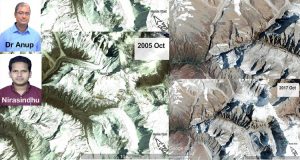#Snow covers depleting in Hindu Kush Himalayan region
by Ashis Sinha
 Giving a clarion call for the implementation of Carbon Capture Technology in the oil and gas sectors, IIT-ISM, Dhanbad researchers appealed for efforts to reduce the emission of greenhouse gases.
Giving a clarion call for the implementation of Carbon Capture Technology in the oil and gas sectors, IIT-ISM, Dhanbad researchers appealed for efforts to reduce the emission of greenhouse gases.
In an ‘eye opener’ research conducted by a team of the tech cradle IIT (ISM), Dhanbad reveals a significant decrease in snow cover in the low altitudinal region of the Hindu Kush Himalayan (HKH) region.
Recent research conducted by the Department of Applied Geology of one of the oldest premier technical institutes of the country, IIT (ISM) Dhanbad, indicated a significant decline in the snow cover (from 5-15%) in the central zone and eastern zone of Hindu Kush Himalayan Region.
The study conducted by the department as part of the research of Ph. D. scholar Nirasindhu Desinayak under the guidance of Dr Anup Krishna Prasad, associate professor of the Applied Geology Department, attributed the depletion of snow cover and melting of glaciers, including others, to the warming tendency of the atmosphere (troposphere) over the Himalayas, informed Rajni Singh, Dean Media and Branding, IIT (ISM).
The research, based on the analysis of seismic data of the regions from 2000-to 2017 further calls for the initiation of efforts to reduce or control the emission of greenhouse gases like Carbon oxide (CO2) and Methane (CH4).
The findings of the research also highlighted the need for implementing Carbon Capture Technologies in the Oil and Gas sector and Coal Fired Thermal Power Plants.
The research also underlined the need for the usage of low carbon energy sources besides the development of hydro, solar and wind power and, at the same time, lays stress on the capture of Carbon through afforestation and algal farming (biofuels).
The research was conducted with the additional guidance of three USA based experts, including Professor Hesham El Askary of Centre of Excellence in Earth Systems Modelling and Observations, Schmid College of Science and Technology, Chapman University, USA; Professor Menas Kafatos, Director of the same institute at Chapman University besides Ghassem R Arsar, Senior Vice President for Science, Universities Space Research Association (USRA), Columbia.
The five-year research conducted from 2015 onwards on the basis of analysis of seismic data sets from the HKH region from 2000 to 2017 describes long term altitudinal variations and variability in coverage of snow and glaciers of the world’s greatest mountain region Hindu Kush Himalayas.
Elaborating on the findings of the research Dr Anup Krishna Prasad said, “The western zone or High altitude Region (above 6000 meters) of HKH exhibit no significant loss in snow cover in the same period of 2000-2017 when the central zone witnessed a significant decline of snow cover.
“Such large, anomalous, and significant changes in snow cover in the HKH region and particularly in the central region of 2000-6000 meter altitude indicate an immediate impact on river discharge, which is anticipated to raise the level of major rivers of Asia,” added Dr Prasad.
“The rising loss of snow cover in relatively low altitude regions (2000- 6000 meters), which can reach as high as 15% in some regions, necessitates the monitoring of all such zones, “opined Dr Prasad.
The challenges posed by the depleting snow cover, Prasad said, “It is likely to increase the number of natural snow melt lakes in Himalaya which pose a risk to the downstream settlements due to possibility of rapid bursting.” “The losses due to glacial melt lakes can be minimised through mapping of these melt lakes,” explained Prasad.
Moreover, with the snow cover over the HKH region known to influence the monsoon over the Indian Subcontinent, these relatively quick changes (significant loss of snow cover) are expected to influence the monsoon rainfall distribution across India.


